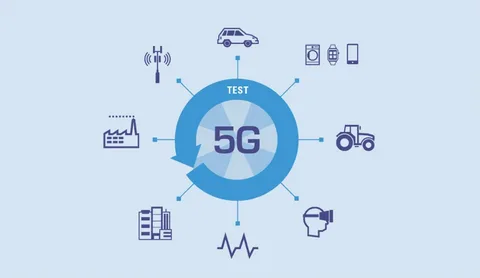5G technology is not just an upgrade from previous networks. It’s a complete transformation of how we connect and communicate. Unlike earlier generations, 5G offers lightning-fast high-speed connectivity and incredibly low latency, making it ideal for real-time communication. This means activities like gaming, video calls, and streaming work smoother than ever.
Moreover, 5G benefits extend beyond speed. Its ability to connect millions of devices simultaneously paves the way for innovations like smart cities and the Internet of Things (IoT). These advancements enable smarter homes, more efficient industries, and revolutionary services such as remote surgeries and public safety applications.
Why Is 5G Better Than 4G?

The evolution from 4G to 5G marks a significant leap in telecommunications evolution. While 4G focused on improving mobile broadband, enhanced mobile broadband (eMBB) with 5G delivers up to 100 times faster speeds. This means downloading large files in seconds instead of minutes.
Another major difference is low latency applications. While 4G latency ranges from 30 to 50 milliseconds, 5G reduces this to under one millisecond. This improvement supports mission-critical applications like autonomous vehicles, ensuring they respond instantly to real-time data. The combination of ultra-reliable communications and high-bandwidth solutions makes 5G a game-changer.
you May also read this article: Quaid-E-Azam’s Struggle For Independence: A Timeline Of Bravery
A Few Key Advantages of 5G Over 4G

The advantages of 5G over 4G are transformative. First, it allows for massive IoT with the ability to connect billions of devices. This boosts device density, making innovations like factory automation and 5G-powered smart cities possible. Additionally, 5G network performance ensures seamless connectivity even in crowded spaces.
Industries like healthcare and manufacturing benefit immensely. For example, healthcare advancements with 5G enable remote surgeries and better telemedicine services. In manufacturing, industrial automation with 5G improves efficiency and reduces costs. These examples showcase how 5G enterprise solutions create value across sectors.
6 Key Features and Benefits of 5G
| Feature | Description |
| Faster Data Speeds | Enables high-speed data transfer and real-time updates. |
| Lower Latency | Supports low latency applications like augmented reality (AR). |
| Massive IoT Support | Connects more devices, enhancing connected devices’ scalability. |
| High-Capacity Networks | Handles crowded environments with ease. |
| Energy Efficiency | Prolongs device battery life, supporting future wireless technology. |
| 5G Spectrum Usage | Improves bandwidth allocation for seamless performance. |
These features enhance both personal and industrial experiences. 5G-enabled innovations continue to redefine how we interact with technology, offering limitless possibilities.
More Benefits of 5G mmWave
5G mmWave technology stands out for its incredible speed and capacity. It operates in the 5G spectrum using high-frequency bands, allowing for high-speed data transfer in dense areas. This is perfect for urban settings and events where demand for connectivity surges.
Despite its challenges, like limited range, advanced connectivity solutions like edge computing and virtual networks address these issues. These technologies ensure real-time data processing and improved reliability, pushing the boundaries of what’s possible with 5G.
Who Does 5G Benefit?
5G benefits everyone, from consumers to businesses. For individuals, it provides high-speed connectivity for entertainment, education, and work. Industries gain from 5G private networks that support automation and innovation. For instance, 5G economic impact is evident in sectors like retail and manufacturing, driving efficiency and creating jobs.
Society as a whole also reaps rewards. 5G-powered smart cities improve infrastructure and services, making urban living more efficient. Meanwhile, rural areas in the USA gain access to reliable internet, bridging the digital divide. This makes the future of wireless technology accessible to all.
FAQs
What is 5G, and how does it differ from 4G?
5G technology is the fifth generation of wireless communication, offering high-speed connectivity, low latency, and the ability to connect billions of devices. Unlike 4G, it supports enhanced mobile broadband (eMBB), massive IoT, and mission-critical applications such as remote surgeries and autonomous vehicles.
How does 5G impact industries?
5G is a game-changer for industries, enabling industrial automation with 5G and advancements like real-time data processing and 5G enterprise solutions. Healthcare, manufacturing, and public safety see significant benefits, such as telemedicine, improved factory automation, and public safety applications.
What challenges does 5G face?
One challenge is implementing 5G mmWave, which has limited range but incredible speed. To overcome this, technologies like edge computing and virtual networks help improve reliability and expand coverage.
Who benefits most from 5G?
Everyone benefits from 5G. Consumers enjoy faster downloads and smoother streaming. Businesses gain through 5G private networks, and society benefits from 5G-powered smart cities and bridging the digital divide in rural areas.
Why is 5G important for the USA?
5G drives 5G economic impact, supporting innovation and job creation. It ensures the USA remains competitive in technology and provides better connectivity for urban and rural areas alike.
Conclusion
The rollout of 5G technology is transforming the way people and industries connect, work, and innovate. Its high-speed connectivity, low latency, and ability to support massive IoT are unlocking opportunities in areas like healthcare, manufacturing, and public safety. From enabling remote surgeries to advancing factory automation, 5G stands as a cornerstone of modern technology.Moreover, the impact of 5G extends to everyday lives and national growth. By powering smart cities, bridging rural internet gaps, and boosting industries, 5G is shaping a more connected and efficient world. As the future of wireless technology, it promises endless possibilities and a significant leap forward for the USA and beyond.







